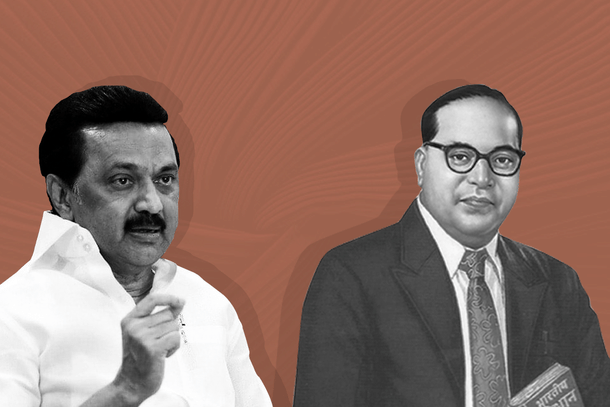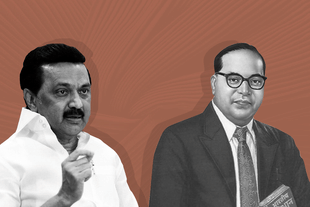Politics
A Look At Constituent Assembly Debates Makes It Clear That 'Union' Only Means A Strong Centre
Adithya Reddy
Jun 25, 2021, 06:06 PM | Updated 06:05 PM IST
Save & read from anywhere!
Bookmark stories for easy access on any device or the Swarajya app.


A controversy has recently erupted in Tamil Nadu over the insistence of Chief Minister M K Stalin and Dravida Munnetra Kazhagam (DMK) leaders to refer to the central government as the Union government or ‘Ondriya Arasu’.
Normally, this controversy should have been ignored not only on the basis of the Shakespearean dialogue “what’s in a name?” but also because there is no actual conflict between the two phrases. But the fact that DMK is justifying its stand by referring to an election manifesto from the heyday of Dravidian 'separatism' and the legal justification offered by some writers, requires some consideration.
Writing for The Hindu, a lawyer claims that “the members of the Constituent Assembly were very cautious of not using the word ‘Centre’ or ‘Central government’ in the Constitution as they intended to keep away the tendency of centralising of powers in one unit”.
This is a highly misleading statement because it implies that the omission of the word ‘Centre’ from the Constitution was made in preference for the de-centralising tendency represented by the word ‘Union’.
On the contrary, the term ‘Union’ was actually chosen in preference over the term ‘federation’ after a long and acrimonious debate between members of the Constituent Assembly over provincial autonomy.
The final decision favoured a strong Centre represented by the term ‘Union’ as opposed to the terms ‘federal union’ or ‘united states’ suggested by members who favoured more autonomy for states.
The following statement of H V Kamath was endorsed by Dr B R Ambedkar:
"The emphasis should be on the word ‘Union’ rather than on the word ‘federal’. The tendency to disintegrate on our body politic has been rampant since the dawn of history and if this tendency is to be curbed the word federal should be omitted from this article".
So amusingly, by insisting on using the word ‘Union’, the DMK under Stalin is endorsing the strong centralist current that shaped the Indian Constitution.
In fact, there could have been no controversy between the terms ‘Union’ and ‘Centre’ during the Constituent Assembly debates because the two terms refer to two different but related concepts with absolutely no mutual animosity.
The term ‘Union’ refers to the nature of the Indian state comprising all three organs whereas the ‘central government’ refers only to its executive wing.
Recently, a parliamentary panel suggested that the term “officials of the Union” be used instead of “Central Government officials” only with reference to employees working in the non-executive branches (judicial and parliamentary staff) thereby reinforcing the basic understanding that the central government is only the executive wing of the Union.
The fact that this is how even the members of the Constituent Assembly saw it, is evident from the manner in which the term ‘central government’ was used during the debates. It was used repeatedly without any controversy to refer to the executive of the future Union.
For instance, B Das from Orissa expressed concern over the role of governors saying, “when the Governor is a nominated Governor, nominated by the President and the Central Government...We have now centralised all power in the hands of the President and the Cabinet, and it is not bad.”
Many other members also referred to the executive as “central government” and this did not attract any controversy. In fact, it is quite common for executives in other Commonwealth democracies like Canada and Australia to be referred as the ‘central government’ in spite of major differences in their constitutional frameworks governing Centre-state relations.
It is also well known that the Indian Constitution has unique features favouring a strong Centre, referring to which the renowned constitutional scholar Dr D D Basu observed as follows:
"India is not a federal state in the traditional sense of the term. There can be no doubt as to the fact, and this is of utmost significance for the purposes at hand, that in the context of India, the principle of federalism is not territory related. This is evident from the fact that India is not a true federation formed by an agreement between various States and territorially. It is open to the Central Government under Article 3 of the Constitution, not only to change its boundaries but even to extinguish a state. Further when it comes to exercising powers, they are weighted heavily in favour of the centre".
In light of this, it is really surprising that people have been claiming that the Constitution preferred the term ‘Union’ consciously in rejection to the term 'Centre'.
More significant is the fact that Stalin is insisting on creating this controversy when both former chief ministers of the state, C N Annadurai and M Karunanidhi, never seemed to have been interested in it.
By relying on a 1957 manifesto in which the term ‘Union’ was supposedly used, Stalin is trying to take his party back to a period before Anna’s famous compromises to bring the DMK within the constitutional fold.
The DMK’s success in the 1962 general elections lead the National Integration Council to form a committee headed by Dr C P Ramaswamy Iyer to recommend measures to strengthen national integrity. The committee’s recommendations lead to the sixteenth amendment to the Constitution which imposed additional restrictions on fundamental rights.
In response, the DMK under Anna purged its constitution and rules of references to 'Dravidistan' to reshape its image within the bounds of the new amendment.
Even before this, in 1959, in response to a challenge from the Congress stalwart and then finance minister C Subramaniam, Anna clarified that all that his party means by opposing “North Indian Domination” is “amendment of the Constitution through perfectly Constitutional Methods” to reduce the Centre’s powers under the Constitution.
This reference to constitutional means was opposed by a faction lead by E V K Sampath eventually leading to his split from the party.
The manner and context in which Stalin’s DMK is insisting on highlighting a non-existent conflict between the terms ‘Union’ and ‘Centre’ show that it wants to rekindle dead emotions. This is a dangerous game probably prompted by Seeman’s decent performance in the recent elections.
Adithya Reddy is a Chennai-based lawyer.





